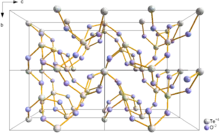The chalcogens react with each other to form interchalcogen compounds.[1]
Although no chalcogen is extremely electropositive,[note 1] nor quite as electronegative as the halogen fluorine (the most electronegative element), there is a large difference in electronegativity between the top (oxygen = 3.44 — the second most electronegative element after fluorine) and bottom (polonium = 2.0) of the group. Combined with the fact that there is a significant trend towards increasing metallic behaviour while descending the group (oxygen is a gaseous nonmetal, while polonium is a silvery post-transition metal[note 2]), this causes the interchalcogens to display many different kinds of bonding: covalent, ionic, metallic, and semimetallic.[note 3][1]
Known binary interchalcogens
| O | ||||||
|---|---|---|---|---|---|---|
| O | S | |||||
| S | Se | |||||
| Se | SexSy | Te | ||||
| Te | TexSy (many unknown) | TexSey (many unknown) | Po | |||
| Po | (many unknown) | PoxSey (many unknown) | PoxTey (unknown) | Lv | ||
| Lv | LvO, LvO2 (predicted) | LvS (predicted) | LvSe (predicted) | LvxTey (predicted) | LvxPoy (predicted) | (predicted) |
Bonding in the binary interchalcogens
Going down the above table, there is a transition from covalent bonding (with discrete molecules) to ionic bonding; going across the table, there is a transition from ionic bonding to metallic bonding. (Covalent bonding occurs when both elements have similar high electronegativities; ionic bonding occurs when the two elements have very different electronegativities, one low and the other high; metallic bonding occurs when both elements have similar low electronegativities.) For example, in the leftmost column of the table (with bonds to oxygen), O2 and O3 are purely covalent, SO2 and SO3 are polar molecules, SeO2 forms chained polymers (stretching in one dimension), TeO2 forms layered polymers (stretching in two dimensions), and PoO2 is ionic with the fluorite structure (spatial polymers, stretching in three dimensions); in the bottom row of the table (with bonds to polonium), PoO2 and PoS are ionic, PoxSey and PoxTey are semimetallic, and Po∞ is metallic.[1]
Summary of known binary interchalcogens
Sulfur chalcogenides

- Lower sulfur oxides, SxOy where the ratio x:y is greater than 1:2
- Disulfur monoxide, S2O
- Disulfur dioxide, S2O2
- Sulfur monoxide, SO
- Sulfur dioxide, SO2
- Sulfur trioxide, SO3
- Higher sulfur oxides, SOx where x > 3
Selenium chalcogenides

- Selenium dioxide, SeO2
- Selenium trioxide, SeO3
- Mixtures of selenium and sulfur in different concentrations with covalent bonding, SexSy
- "Selenium monosulfide", SeS
- "Selenium disulfide", SeS2, actually a 2:1 mixture of cyclo-Se3S5 and cyclo-Se2S6
- "Selenium trisulfide", SeS3, actually occurring as an 8-membered cyclic compound Se2S6 (diselenacyclooctasulfane), where two sulfur atoms in the molecule of cyclooctasulfur are replaced by selenium atoms
Tellurium chalcogenides

- Tellurium monoxide, TeO (unstable transient species)
- Tellurium dioxide, TeO2
- Tellurium trioxide, TeO3
- Ditellurium pentoxide, Te2O5[2]
- Many "alloys" of tellurium and sulfur in different concentrations with semimetallic bonding, TexSy
- Many "alloys" of tellurium and selenium in different concentrations with semimetallic bonding, TexSey
Polonium chalcogenides

- Polonium monoxide, PoO
- Polonium dioxide, PoO2
- Polonium trioxide, PoO3
- Polonium sulfide, PoS
- Many "alloys" of polonium and selenium in different concentrations with semimetallic bonding, PoxSey
- Many "alloys" of polonium and tellurium in different concentrations with semimetallic bonding, PoxTey
Livermorium chalcogenides
Due to the short half-life of all known livermorium isotopes, all proposed compounds shown are theoretical.
- Livermorium(II) oxide, LvO
- Livermorium(IV) oxide, LvO2
- Livermorium sulfide, LvS
- Livermorium selenide, LvSe
- Many "alloys" of livermorium and tellurium in different concentrations with semimetallic bonding, LvxTey
- Alloys of livermorium and polonium in different concentrations with metallic bonding, LvxPoy
See also
Notes
- ↑ This article uses Pauling electronegativity throughout.
- ↑ The classification of polonium as a post-transition metal or a metalloid is disputed.
- ↑ The heavier halogens are sufficiently electronegative to prevent ionic or metallic bonding in the interhalogens, and the lighter pnictogens are not sufficiently electronegative to allow ionic or metallic bonding in the interpnictogens.
References
- 1 2 3 Holleman, Arnold Frederik; Wiberg, Egon (2001), Wiberg, Nils (ed.), Inorganic Chemistry, translated by Eagleson, Mary; Brewer, William, San Diego/Berlin: Academic Press/De Gruyter, pp. 585–586, ISBN 0-12-352651-5
- ↑ Lindqvist, O.; Moret, J. (1973). "The crystal structure of ditellurium pentoxide, Te2O5". Acta Crystallographica Section B: Structural Crystallography and Crystal Chemistry. 29 (4): 643–650. doi:10.1107/S0567740873003092.